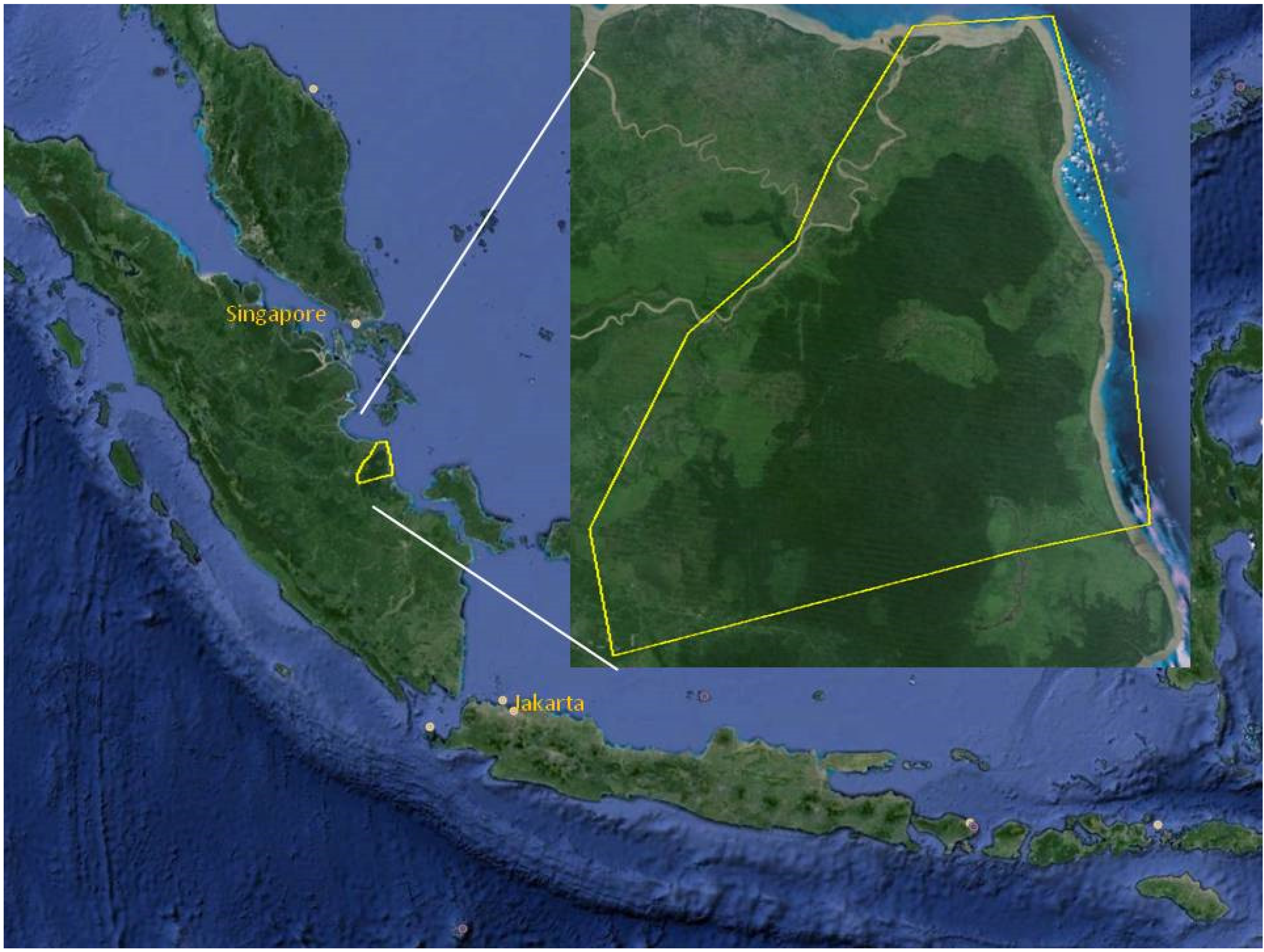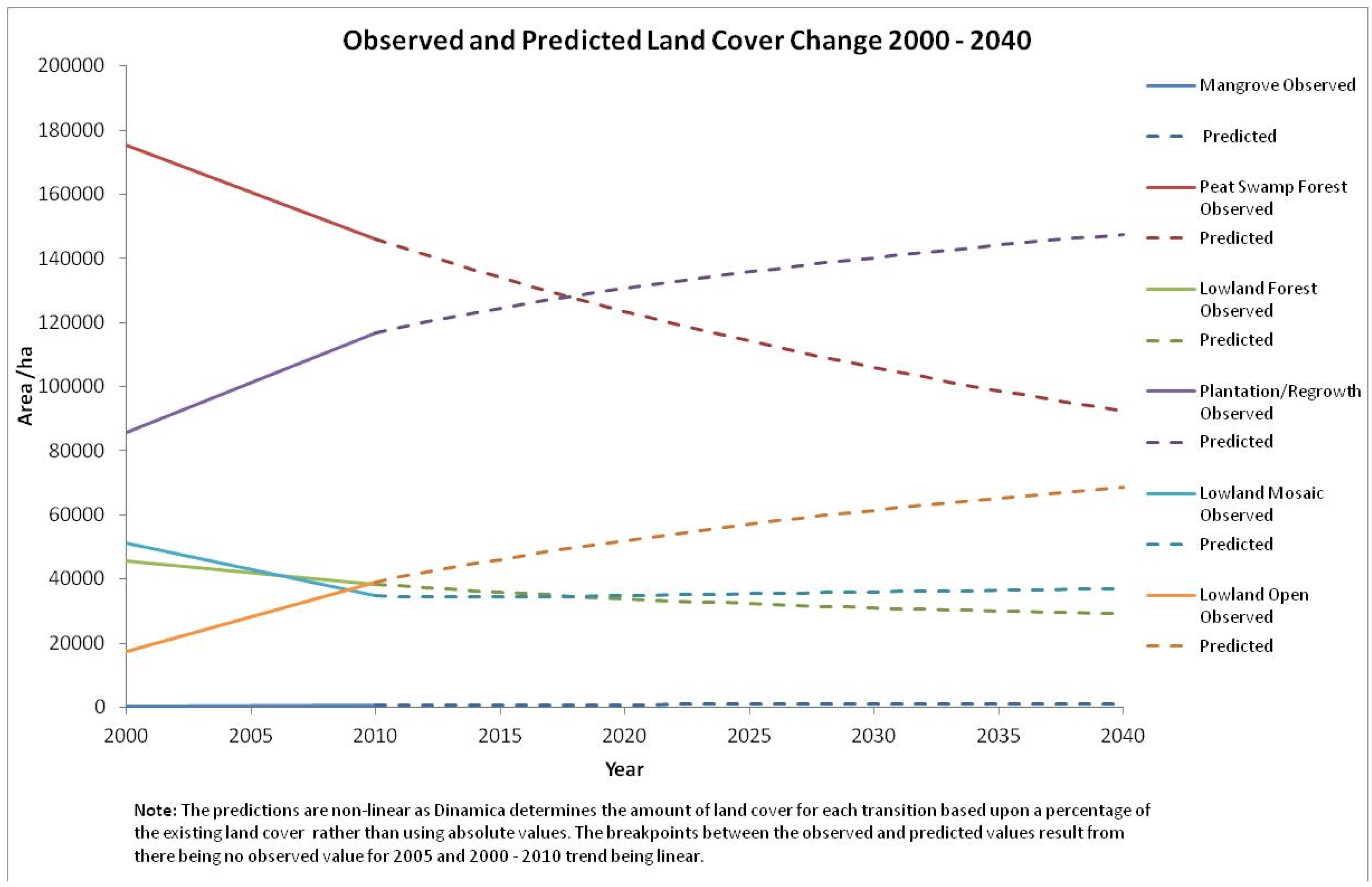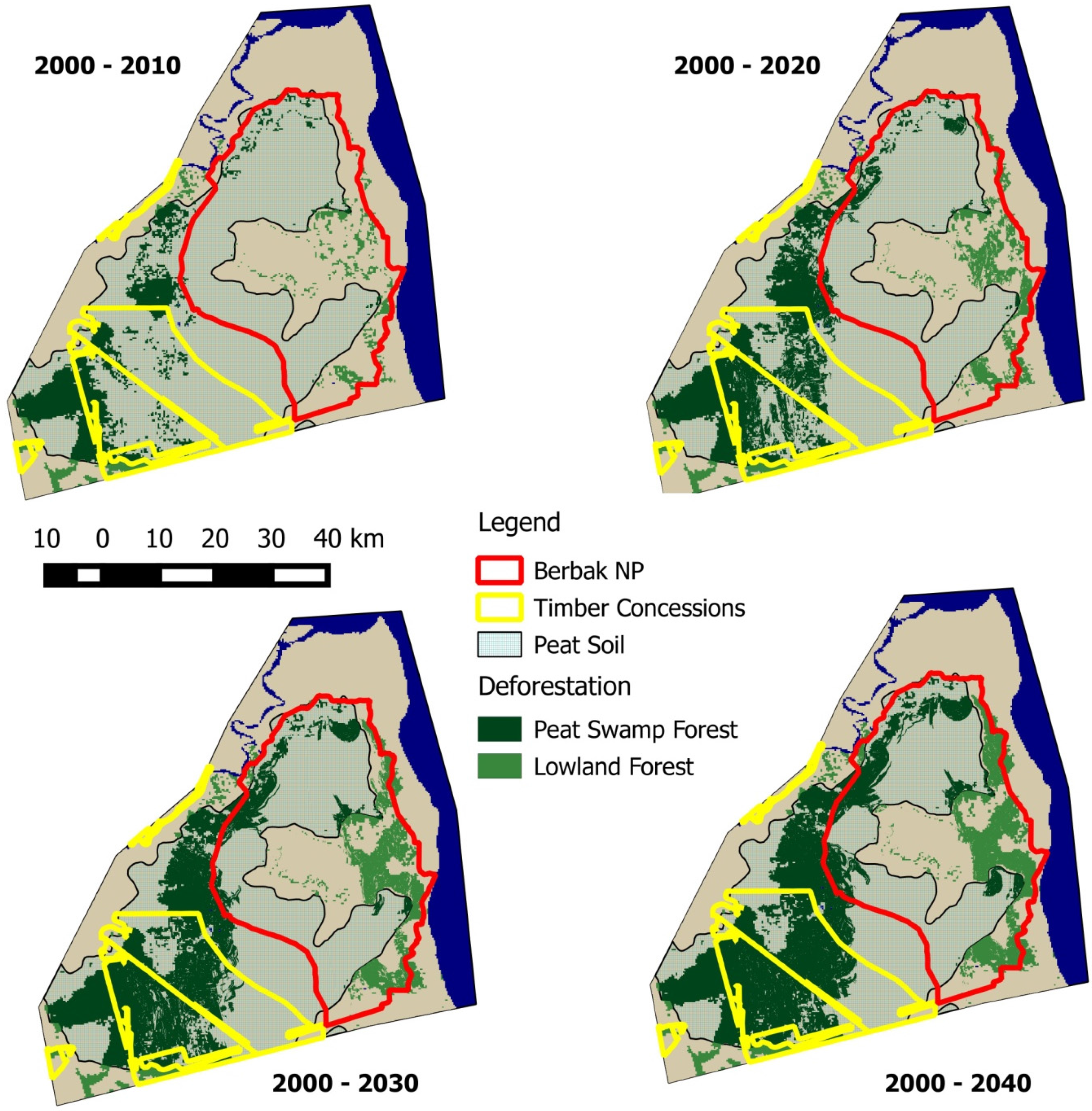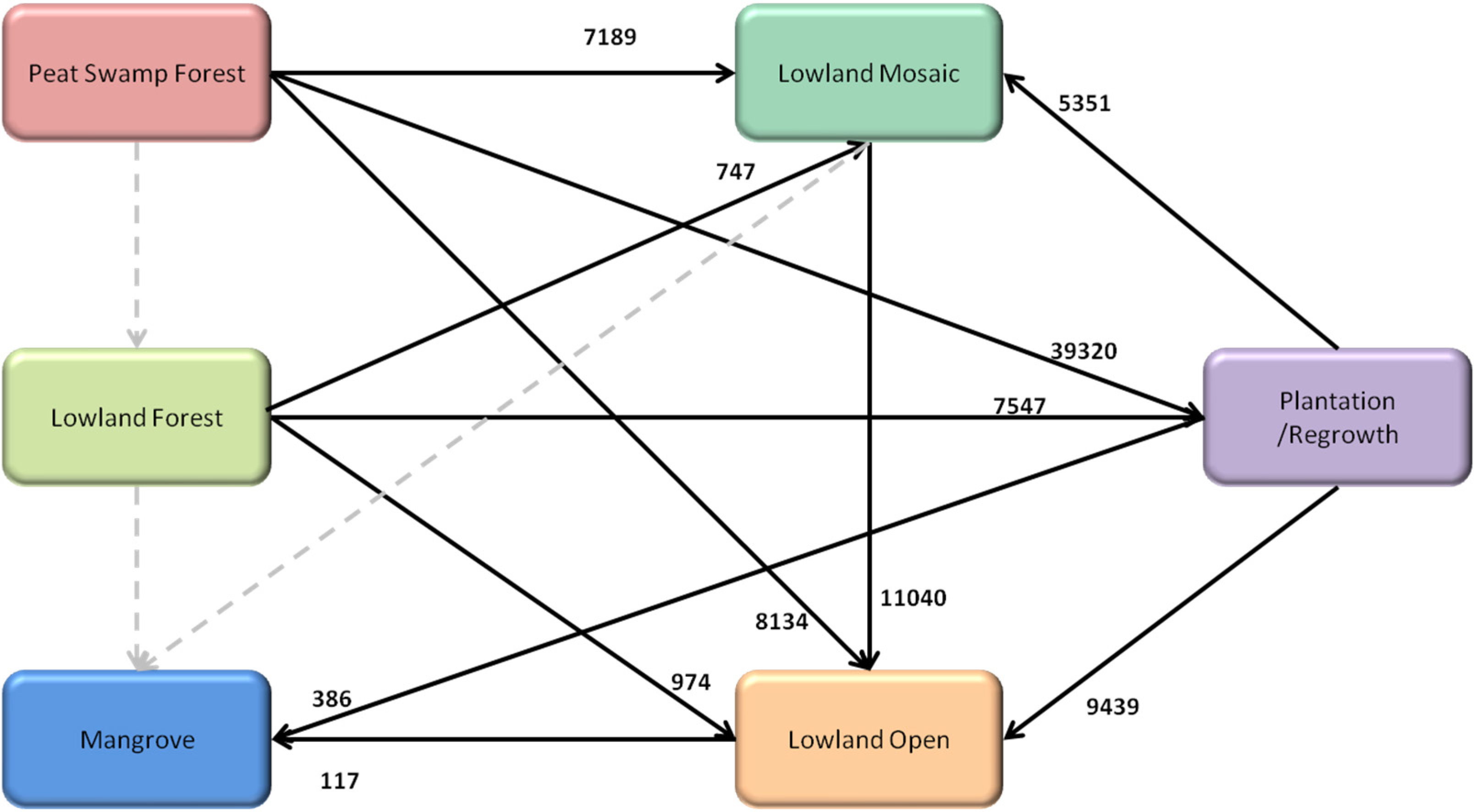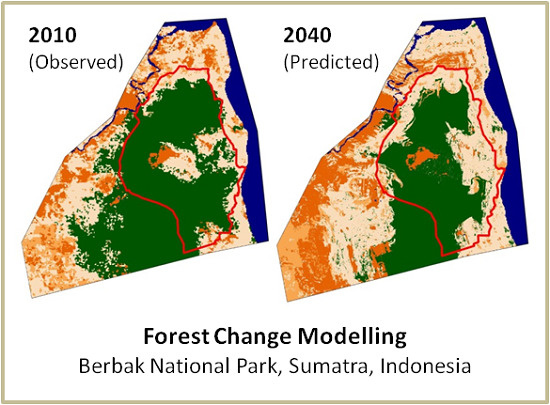3.1. Land Cover Change
The modelled land cover change in the entire study area (
Table 4,
Figure 2 and
Figure 3) shows an overall forest decrease between 2010 and 2040 (lowland, peat swamp and mangrove forest categories) of 62,000 ha (−34%) with the largest land cover category changes being a loss of 53,000 ha of Peat Swamp Forest (−37%) and increases of 30,000 ha for Plantation/Regrowth (+26%) and Lowland Open (+75%). The modelling predicts that 55% of the deforestation occurs in protected forest areas and 86% on peat soil. Importantly, the models show that the core forest area in Berbak National Park and associated protected forest areas remain intact over the study period with deforestation occurring on the edges of the main forest areas.
The output from the model shows annual forest loss rates in the range 1.1% to 1.6%, with an overall predicted annual forest loss for the period from 2010–2040 of 1.36%. This is significantly less than the reported 5% per annum forest loss for the eastern lowlands of Sumatra as a whole for the period 2000–2010 [
5]. The lower figures may result from the protected forest status of the Berbak National Park and adjacent protected forests as well as the inaccessibility of this central forest region. Another factor may be that uncultivated areas are mainly on peat soil which will be the last land to be converted following conversion of more easily cultivated mineral soils.
Table 4.
Projected land cover change (ha) for 30 years at five year intervals from observed data, 2000 & 2010, until 2040. Total Forest includes Mangrove, Peat Swamp and Lowland forests.
Table 4.
Projected land cover change (ha) for 30 years at five year intervals from observed data, 2000 & 2010, until 2040. Total Forest includes Mangrove, Peat Swamp and Lowland forests.
| Year | Mangrove | Peat Swamp Forest | Lowland Forest | Plantation/Regrowth | Lowland Mosaic | Lowland Open | Total Forest |
|---|
| 2000(O) | 414 | 175,292 | 45,678 | 85,647 | 51,175 | 17,287 | 221,383 |
| 2010(O) | 598 | 146,042 | 38,431 | 116,839 | 34,740 | 39,099 | 185,072 |
| 2015 | 703 | 134,088 | 35,913 | 124,520 | 34,385 | 46,142 | 170,703 |
| 2020 | 806 | 123,552 | 33,892 | 130,650 | 34,803 | 52,047 | 158,249 |
| 2025 | 906 | 114,255 | 32,274 | 135,822 | 35,387 | 57,105 | 147,435 |
| 2030 | 1003 | 106,046 | 30,985 | 140,281 | 35,962 | 61,472 | 138,034 |
| 2035 | 1097 | 98,797 | 29,965 | 144,153 | 36,483 | 65,254 | 129,859 |
| 2040 | 1185 | 92,393 | 29,166 | 147,530 | 36,942 | 68,532 | 122,744 |
| Area Change 2000–2010 | 184 | −29,250 | −7247 | 31,192 | −16,435 | 21,812 | −36,311 |
| Area Change 2010–2040 | 587 | −53,649 | −9265 | 30,691 | 2203 | 29,433 | −62,328 |
| % Change 2010–2040 | 98.1% | −36.7% | −24.1% | 26.3% | 6.3% | 75.3% | −33.7% |
| % Annual Change 2000–2010 | 3.76% | −1.81% | −1.71% | 3.15% | −3.80% | 8.50% | −1.78% |
| % Annual Change 2010–2040 | 2.30% | −1.51% | −0.92% | 0.78% | 0.21% | 1.89% | −1.36% |
Figure 2.
Observed and Projected Land Cover Change 2010–2040.
Figure 2.
Observed and Projected Land Cover Change 2010–2040.
Figure 3.
Land Cover Maps 2000–2040 showing land cover and extent of Berbak NP.
Figure 3.
Land Cover Maps 2000–2040 showing land cover and extent of Berbak NP.
Of significant interest are the projected forest changes in specific subsections of the study area, particularly the protected forest areas and the peat soil areas (
Table 5 and
Table 6). The protected forest areas comprise 193,294 ha, 51.4% of the study area, of which 72% was forested in 2010. It is projected that forest loss of 34,000 ha will occur within these areas during the 30-year period up to 2040, representing a 26% forest loss. The largest increase is in the Plantation/Regrowth Category of 25,000 ha.
In the peat soil areas, covering 209,483 ha (55.8% of the study area) the projected forest loss is 53,000 ha,
i.e., 37% of the 2010 forest cover. Analysis of predicted annual change in the forest cover in peat soil areas shows annual deforestation rates in the range of 1.3% year
−1 to 1.7% year
−1. This is less than the peat swamp deforestation rates for insular Southeast Asia of 2.2% year
−1 and 5.2% for all Sumatra over the period 2000–2010 [
5]. The lower deforestation rate in the study area may be less than that for insular Southeast Asia and Sumatra as 59% of the peat soil area is located within protected forest areas.
Table 5.
Land Cover Change (ha) in Protected Areas. (Category Mangrove is not present in Protected Forest areas.)
Table 5.
Land Cover Change (ha) in Protected Areas. (Category Mangrove is not present in Protected Forest areas.)
| Year | Peat Swamp Forest | Lowland Forest | Plantation/Regrowth | Lowland Mosaic | Lowland Open | Total Forest |
|---|
| 2000 | 112,630 | 38,354 | 27,044 | 8945 | 6313 | 150,984 |
| 2010 | 102,774 | 35,404 | 39,185 | 5903 | 10,029 | 138,178 |
| 2015 | 98,524 | 33,569 | 45,492 | 4591 | 11,119 | 132,093 |
| 2020 | 93,308 | 31,931 | 49,204 | 6600 | 12,251 | 125,239 |
| 2025 | 88,114 | 30,489 | 53,068 | 8145 | 13,479 | 118,603 |
| 2030 | 83,965 | 29,292 | 56,803 | 8375 | 14,859 | 113,257 |
| 2035 | 80,007 | 28,302 | 60,460 | 9108 | 15,418 | 108,308 |
| 2040 | 75,964 | 27,484 | 64,203 | 9172 | 16,472 | 103,448 |
| Area Change 2000–2010 | −9856 | −2950 | 12,142 | −3042 | 3716 | −12,806 |
| Area Change 2010–2040 | −26,810 | −7920 | 25,018 | 3269 | 6,443 | −34,7230 |
| % Change 2010–2040 | −26.1% | −22.4% | 63.8% | 55.4% | 64.2% | −25.1% |
Table 6.
Land Cover Change (ha) in Peat Soil Areas. (Category Mangrove is not present in Peat Soil areas.)
Table 6.
Land Cover Change (ha) in Peat Soil Areas. (Category Mangrove is not present in Peat Soil areas.)
| Year | Peat Swamp Forest (/ha) | Lowland Forest (/ha) | Plantation/Regrowth (/ha) | Lowland Mosaic (/ha) | Lowland Open (/ha) | Total Forest (/ha) |
|---|
| 2000 | 171,605 | 2705 | 23,418 | 9774 | 1982 | 174,310 |
| 2010 | 142,155 | 2812 | 39,003 | 16,174 | 9340 | 144,967 |
| 2015 | 130,200 | 2818 | 42,179 | 22,581 | 11,705 | 133,019 |
| 2020 | 119,662 | 2834 | 48,152 | 22,994 | 15,842 | 122,495 |
| 2025 | 110,365 | 2838 | 52,497 | 22,927 | 20,857 | 113,203 |
| 2030 | 102,156 | 2841 | 57,672 | 22,576 | 24,238 | 104,997 |
| 2035 | 94,907 | 2851 | 62,781 | 22,172 | 26,772 | 97,758 |
| 2040 | 88,503 | 2862 | 66,344 | 22,703 | 29,071 | 91,365 |
| Area Change 2000–2010 | −29,450 | 107 | 15,585 | 6400 | 7358 | −29,343 |
| Area Change 2010–2040 | −53,652 | 50 | 27,341 | 6529 | 19,731 | −53,602 |
| % Change 2010–2040 | −37.7% | 1.8% | 70.1% | 40.4% | 211.3% | −37.0% |
The model predictions show that the protected forest areas suffer from a lower percentage forest loss than non-protected areas but still 56% of all deforestation is predicted to occur in protected areas and 86% of all deforestation is predicted to occur in peat soil areas. Deforestation in peat soil areas is often associated with a lowering of the water table for agricultural use. Lowering the water table results in enhanced rates of peat oxidation and loss of stored carbon to the atmosphere in addition to the loss of carbon in forest biomass. In areas of Timber Concessions the forest will decline by 62% reducing from 64% of land cover in 2010 to 24% in 2040.
The deforestation areas,
Figure 4, predict that while there was limited deforestation in Berbak NP between 2000 and 2010 this will increase in the following decades. Peat swamp forest deforestation occurs in the west of Berbak NP while lowland forest loss will occur to the east. While there has been some significant deforestation in the timber concessions by 2010 the model predicts that this area will be almost totally deforested by 2040.
Figure 4.
Deforestation 2000–2040 showing areas of deforestation for Peat Swamp and Lowland forest with peat soil area, Berbak National Park and timber concessions.
Figure 4.
Deforestation 2000–2040 showing areas of deforestation for Peat Swamp and Lowland forest with peat soil area, Berbak National Park and timber concessions.
While the original land cover map (2000) did not include the Oil Palm Plantation (OPP) category planted oil palm plantations most probably existed in 2000. Koh
et al. [
10] indicate that the land cover identified in the 2010 land cover map was created as a subset of the plantation/regrowth category and consisted of closed canopy oil palm plantation which must have been planted in 2003 or earlier. Much of this oil palm plantation was probably planted prior to 2000. In the 2010 land cover map the Oil Palm Plantation comprises 12% of the combined plantation/regrowth and oil palm plantation categories, 14,446 ha. As this only includes the closed cover oil palm plantation this is a minimum estimate. If the oil palm plantation were restricted to the same percentage of the plantation/regrowth category in the 2040 prediction then the area of oil palm will have grown to 45,000 ha which is growth of over 200%. There may also be issues with more recent regulations regarding oil palm plantations which will limit the growth areas, for example, the recent Law on Prevention and Eradication of Forest Destruction issued by the Government of Indonesia in 2013 and the commitment by many companies trading in and using palm oil to sustainable practice, e.g., Wilmar International, the world’s largest palm oil trader, committed to “no deforestation”, “no peat”, and “no exploitation” (Wilmar International, 2013). The factors influencing oil palm plantation growth, economic and political, and the designation of oil palm leases along with the planning required for development of plantations may require that oil palm plantation growth should be modelled separately, e.g., as undertaken by Carlson (2012).
No individual modelling of El Niño Southern Oscillation (ENSO) events was undertaken as part of this study. The available land cover maps did not allow separation of the specific, time-limited land cover changes occurring during ENSO versus non-ENSO periods. The ten-year period between the initial and final land cover maps will have captured three ENSO events, 2002–2003, 2004–2005 and 2009–2010 [
37] resulting in the effects of these events being included in the model output. Impacts of drought resulting from ENSO can be unpredictable as the impact of fires will vary between ENSO events. This is illustrated by the impact of the 1997–1998 ENSO, outside the study training and prediction period, which resulted in severe fires which impacted the Berbak landscape [
16]. It is difficult to include severe ENSO events in land cover change modelling due to the unpredictability of their occurrence.
The prediction model shows land cover transitions which were not included in the original transition matrices determined as an input to the model. This will occur due to multiple land cover transitions occurring during the modelling period. The same effect occurred in the original transition matrices due to the 10-year period between the initial and final observed land cover models but these transitions were removed from the transition matrix used in the model. This will not affect the overall outcome of the model, however, as it only masks short term transitions by longer term ones.
It is necessary to understand the net transitions which have occurred between land cover types as these are the significant changes from which calculations of business as usual biomass change calculations can be calculated and to understand the trend in land cover changes (
Figure 5). This shows a general trend from forested areas, peat swamp and lowland, to the categories, open, mosaic and plantation/regrowth. Almost 72% of deforestation on peat soils (PSF) and 81% of deforestation on mineral soils (LLF) changes to plantation/regrowth, although some of the plantation/regrowth is cleared for other agricultural purposes.
Figure 5.
Net land cover transitions in hectares (only showing transitions >100 ha) over 30-year projection. Data from
Table 7 rounded to nearest 100 ha. Minor transitions shown by grey dashed arrows.
Figure 5.
Net land cover transitions in hectares (only showing transitions >100 ha) over 30-year projection. Data from
Table 7 rounded to nearest 100 ha. Minor transitions shown by grey dashed arrows.
3.4. Model Limitations
Land change models can only provide projections based upon the inputs to the model. Depending upon the historical period chosen the model can over or underestimate future change [
21] Over or underestimation may occur as a result of fluctuations in the annual land change rates. The ten year historical period used for calibrating the model removes the impact of annual fluctuations on the predicted output.
Deforestation rates will vary over time and the model predicts that deforestation rates will be lower in the prediction period than in the calibration period,
Table 4. This occurs as the Dinamica model determines transitions as a percentage of the existing land cover for each land cover type transition. As the area of forest declines the amount of deforestation decreases but as plantation/regrowth area increases the reforestation area increases. This may not represent an accurate deforestation/reforestation scenario as reforestation takes longer to occur than deforestation.
The model shows projected transitions over the period from 2010–2040 which would not occur in nature, notably the transitions between the peat swamp and lowland forest types,
Table 7. Small differences in the original maps show 12.5 ha of peat forest being converted to lowland forest between 2000 and 2010. These small anomalies are not considered significant in relation to the whole study area. To remove this peat to lowland forest transition, forest types found in the earlier map, 2000, were corrected to align with the 2010 map on the assumption that the later study was more accurate.
The soil maps provided by the Jambi REDD+ Commission used in this study were different from those used for the CRISP land cover maps with discrepancies indicated by small areas of lowland forest shown to be on peat soil and peat swamp forest on mineral soil. This difference in soil type maps may also have contributed to the forest type transitions observed in the model.
Small area changes between forest types over the 30 year prediction period could have been removed by changes to the model, either by splitting the model by soil type or by modification of the transition coefficients to reduce the probability of forest transitions being assigned to the “wrong” soil type. However, due to the very small areas concerned these changes were not considered to be warranted.
The lack of accurate identification of all oil palm plantations in input land cover maps and the removal of this category from the land cover model is a more significant limitation as it does not allow determination of the impact of oil palm plantations on deforestation. This deficiency may compromise future forest management proposals. For users interested in applying these products to determine REDD+ baseline levels, it should be noted that the land change model only predicts future change based upon the historical evidence and does not consider other proposals, e.g., reduction in the amount of timber which may be cut, which may impact deforestation rates [
21]
